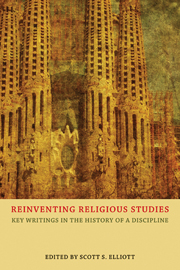Book contents
- Frontmatter
- Contents
- Introduction
- 1 For such a time as this: the Council of Societies for the Study of Religion, 1969–2009
- Part I Inventing and reinventing the field of religious studies
- Part II Method and theory in religious studies
- Part III Teaching religion
- 14 Confessions of a former establishment fundamentalist
- 15 Confessing away the soul with the sins, or the risks of Uncle Tomism among the humanists: a reply to Robert Bellah
- 16 Criteria for organizing the introductory course in religion
- 17 Teaching about religion at the state university: taking the issue seriously and strictly
- 18 Teaching about religion at the state university: a reply
- 19 Teaching about religion at the religiously affiliated university: taking the issue seriously and strictly—a reply to Robert Baird and Robert Minor
- Part IV Women and the bible in religious studies
- Part V Religion and religious studies in civic life
- Part VI Religious studies and identity politics
- Part VII Islam and 9/11
- Bibliography
- Acknowledgments
- Index
18 - Teaching about religion at the state university: a reply
from Part III - Teaching religion
- Frontmatter
- Contents
- Introduction
- 1 For such a time as this: the Council of Societies for the Study of Religion, 1969–2009
- Part I Inventing and reinventing the field of religious studies
- Part II Method and theory in religious studies
- Part III Teaching religion
- 14 Confessions of a former establishment fundamentalist
- 15 Confessing away the soul with the sins, or the risks of Uncle Tomism among the humanists: a reply to Robert Bellah
- 16 Criteria for organizing the introductory course in religion
- 17 Teaching about religion at the state university: taking the issue seriously and strictly
- 18 Teaching about religion at the state university: a reply
- 19 Teaching about religion at the religiously affiliated university: taking the issue seriously and strictly—a reply to Robert Baird and Robert Minor
- Part IV Women and the bible in religious studies
- Part V Religion and religious studies in civic life
- Part VI Religious studies and identity politics
- Part VII Islam and 9/11
- Bibliography
- Acknowledgments
- Index
Summary
We agree wholly with Robert Minor and Robert Baird's initial point in the lead article in the June 1983 issue of the CSR Bulletin: “Because of the public and tax-supported nature of the state university, it is inappropriate to teach religion there” (69). Furthermore, in such a setting, and given the real and perceived “power differential” between faculty and students occasioned principally by the giving and receiving of grades, to teach religion rather than teaching about it is an assault on the students' integrity and personhood. The distinction between these two approaches to the subject is the central topic of the first two lectures in both Comparative Religion and Religion in American Culture; we consider it extremely important.
However, Minor and Baird's first, virtually non-contestable premise does not entail the myriad conclusions they draw from it.
LEGITIMATE VERSUS ILLEGITIMATE GOALS
They first give three reasons why it is difficult to teach about religion. First, “advocating practical religious methods, worldviews, or affective matters are the issues with which religions deal; and therefore, to advocate one alternative over another is to take a religious stance” (Minor & Baird 1983: 69). This is an invalid argument. Various religions take stances on nuclear war, human rights, etc. Let X be their position on these topics. If I accept X it does not follow that I am taking a religious stance. Religions may deal with a topic, T, as may political groups, etc.
- Type
- Chapter
- Information
- Reinventing Religious StudiesKey Writings in the History of a Discipline, pp. 111 - 114Publisher: Acumen PublishingPrint publication year: 2013



